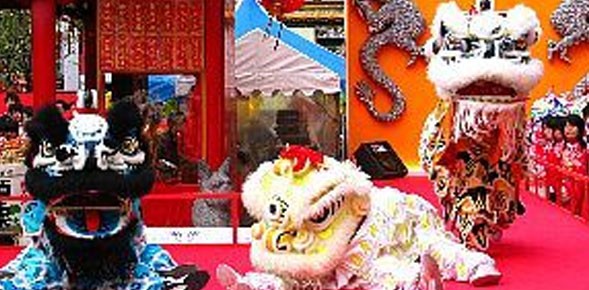China and Japan might be at odd over territorial disputes but it does not deter Japanese metropolis of Nagasaki, Kobe and Yokohama to host Chinese New Year festivals as these cities still have the three largest Chinatowns in the country…
KOBE/NAGASAKI/YOKOHAMA- In Kobe (Kansai), “Nankin-machi” is one of Japan’s three largest Chinatowns along with those in Yokohama and Nagasaki. It will host Shun-Setsu-Sai, an arranged form of Chinese New Year Celebration (lunar New Year), is held every year. In 2013, the eight-day festival will take place from February 10 to February 17.
The festival features dragon and lion dance performances, which are indispensable for Chinese celebrations, as well as a parade of people dressed in the costumes of Chinese historical figures, and acrobatic demonstrations. Also designated as a regional intangible folk cultural property of Kobe, “Shun-Setsu-Sai” attracts many tourists from both Japan and overseas every year.
The most distinctive feature of Kobe’s Chinatown is its compact area of 300 m from east to west and 100 m from north to south, in which colourful Chinese restaurants and stores offering Chinese groceries and sundry goods, stand side by side. So visitors can casually enjoy an authentic exotic atmosphere, as if they were actually visiting China. In addition to Shun-Setsu-Sai in spring, an event concurrent with Chu-Shu-Setsu (Mid-Autumn Festival) is held in autumn.
Nagasaki (Kyushu) was one of the few cities in Japan to have been opened to foreign trade and visitors. It was even the only open port during 300 years in the Japanese archipelago. This is why the Chinese New Year takes a specific character in this rather small metropolis of 400,000 inhabitants.
Nagasaki Lantern Festival marks then the beginning of the Chinese New Year according to the lunar calendar. The New Year is welcomed with colourful lights and lanterns in Nagasaki. Processions are led through the streets, with one of the most popular being the Kotei Parade, where locals dress in traditional Japanese costumes and march around areas of central Nagasaki. Festivities usually last for two weeks and also include dragon dances and firecrackers.
For visitors in Tokyo, the neighbouring city of Yokohama ( a 15-minute ride by bullet train or less than 30 mn away by commuter train) organizes a colourful Chinese New Year festival. Called “Spring Festival”, the festivity will be hosted on February 10. Fire crackers, dances accompanied with cymbals, drums, and Chinese gongs along with Chinese lions and dragons will be held all over Chinatown.
Yokohama celebrations include also the Memorial Spring Festival Nocturnal Flower Illumination with lanterns all over the district. One of the highlights will be a giant parade to celebrate the New Year’s with costumes of the Emperor, ethnic clothing, lion dance, and dragon dance on January 20 at Yamashita Park. On February 10, a Lion Dance will take place while the Lantern Festival will take place on February 24. The event, where lanterns with messages of wishes and dreams are dedicated and send a peace message to heaven, will mark the last day of the Chinese New Year.
Luc Citrinot a French national is a freelance journalist and consultant in tourism and air transport with over 20 years experience. Based in Paris and Bangkok, he works for various travel and air transport trade publications in Europe and Asia.



![[PR] PR_Ascott and Vimut Hospital_2024](https://www.traveldailynews.asia/wp-content/uploads/2024/04/PR-PR_Ascott-and-Vimut-Hospital_2024-400x265.jpg)







































































